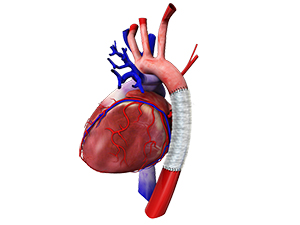Open Surgical Aneurysm Repair
 An aneurysm is a balloon like enlarged and weakened area (caused due to blood pressure) on the wall of an artery. An aneurysm can cause serious complications when it increases in size and ruptures or when blood clots block the blood flow. Aneurysms can be safely treated by surgical repair. In surgical aneurysm repair, your surgeon repairs or removes an aneurysm to promote normal blood flow.
An aneurysm is a balloon like enlarged and weakened area (caused due to blood pressure) on the wall of an artery. An aneurysm can cause serious complications when it increases in size and ruptures or when blood clots block the blood flow. Aneurysms can be safely treated by surgical repair. In surgical aneurysm repair, your surgeon repairs or removes an aneurysm to promote normal blood flow.
Aneurysms occur mostly in the aorta, the largest artery in your body running from your heart through the chest and abdomen. Surgical aneurysm repair is indicated for the treatment of abdominal aortic aneurysm, an aneurysm that occurs in your abdomen and for thoracic aortic aneurysm, an aneurysm that occurs in your chest. This method is also employed for the treatment of aneurysm in arteries located in your thigh, spleen, knee, kidneys, liver, and stomach.
At first, your physician will obtain your medical history and perform a physical examination. You may be ordered to get some tests done such as a CT scan, duplex ultrasound and angiography. Your doctor might ask you not to eat or drink anything for 8 hours before the surgery. Your doctor will also discuss with you whether you need to reduce the dose or stop taking certain medications.
You will be given anesthesia to block the pain during the surgery. Your vascular surgeon will make a small incision in your skin and muscle over the artery with the aneurysm. The surgeon exposes the aneurysm site and clamps the artery above the aneurysm to stop the blood flowing through the area. The aneurysm is cut opened to remove the blood clots and plaque deposits. Your surgeon may insert a graft that is attached just above and below the aneurysm to bypass the weakened area. Alternately, your surgeon may attach a fabric patch to the wall of the artery to strengthen it and decrease its size. Or, a tiny metal or plastic coil is inserted using a catheter into the area of the aneurysm. These methods all help to facilitate normal blood flow.
You will be shifted to the intensive care unit after surgery and you will be monitored continuously till you recover. You may need to stay in the hospital for 7-10 days until your physician considers your health to have improved satisfactorily. You will be advised not to lift anything and to follow the diet instructions strictly.
The complications of surgical aneurysm repair include:
- Breathing problems
- Heart problems
- Colon problems
- Kidney problems







